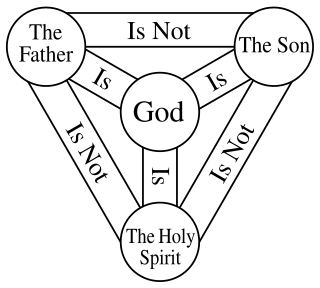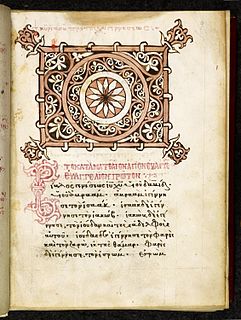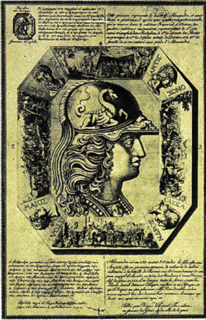This article needs additional citations for verification .(May 2011) (Learn how and when to remove this template message) |
The Latin phrase in saecula saeculorum expresses the idea of eternity and is literally translated as "unto the ages of ages." The phrase occurs in the New Testament in the Vulgate and translates the original Koine Greek phrase "εἰς τοὺς αἰῶνας τῶν αἰώνων" (eis toùs aionas ton aiṓnōn), found e.g. at Phillippians 4:20. The phrase expresses the eternal duration of God's attributes. Other variations of the phrase are found at e.g. Eph 3:21, as εἰς πάσας τὰς γενεὰς τοῦ αἰῶνος τῶν αἰώνων, ἀμήν, here referring to the glory of God the Father; this may be translated as "from all generations for ever and ever, amen".

Latin is a classical language belonging to the Italic branch of the Indo-European languages. The Latin alphabet is derived from the Etruscan and Greek alphabets and ultimately from the Phoenician alphabet.

Eternity in common parlance is an infinitely long period of time. In classical philosophy, however, eternity is defined as what exists outside time while sempiternity is the concept that corresponds to the colloquial definition of eternity.

The New Testament is the second part of the Christian biblical canon, the first part being the Old Testament, based on the Hebrew Bible. The New Testament discusses the teachings and person of Jesus, as well as events in first-century Christianity. Christians regard both the Old and New Testaments together as sacred scripture. The New Testament has frequently accompanied the spread of Christianity around the world. It reflects and serves as a source for Christian theology and morality. Extended readings and phrases directly from the New Testament are incorporated into the various Christian liturgies. The New Testament has influenced religious, philosophical, and political movements in Christendom and left an indelible mark on literature, art, and music.
Contents
The translation of aiōnes can be temporal, in which case it would correspond to the English "ages". Then again, it can be spatial, and then one would need to translate in spatial terms, describing the cosmos so as to include both the heavenly and earthly world.
The phrase occurs twelve times in the Book of Revelation alone, and another seven times in epistles, but not in the gospels:

The Book of Revelation, often called the Revelation to John, the Apocalypse of John, The Revelation, or simply Revelation, the Revelation of Jesus Christ or the Apocalypse, is the final book of the New Testament, and therefore also the final book of the Christian Bible. It occupies a central place in Christian eschatology. Its title is derived from the first word of the text, written in Koine Greek: apokalypsis, meaning "unveiling" or "revelation". The Book of Revelation is the only apocalyptic document in the New Testament canon.
- Galatians 1:5: "... δόξα εἰς τοὺς αἰῶνας τῶν αἰώνων, ἀμήν."
- Philippians 4:20: "...δόξα εἰς τοὺς αἰῶνας τῶν αἰώνων, ἀμήν."
- 1 Timothy 1:17: "...δόξα εἰς τοὺς αἰῶνας τῶν αἰώνων, ἀμήν."
- 2 Timothy 4:18: "...δόξα εἰς τοὺς αἰῶνας τῶν αἰώνων, ἀμήν."
- Hebrews 13:21: "...δόξα εἰς τοὺς αἰῶνας [τῶν αἰώνων], ἀμήν."
- 1 Peter 4:11: "...δόξα καὶ τὸ κράτος εἰς τοὺς αἰῶνας τῶν αἰώνων, ἀμήν."
- Revelation 1:6: "...δόξα καὶ τὸ κράτος εἰς τοὺς αἰῶνας [τῶν αἰώνων] · ἀμήν."
- 5:13: "...δόξα καὶ τὸ κράτος εἰς τοὺς αἰῶνας τῶν αἰώνων."
- 7:12, 10:6, 11:5, 15:7, 19:3, 20:10, 22:5: "... εἰς τοὺς αἰῶνας τῶν αἰώνων"

The Epistle to the Galatians, often shortened to Galatians, is the ninth book of the New Testament. It is a letter from Paul the Apostle to a number of Early Christian communities in Galatia. Scholars have suggested that this is either the Roman province of Galatia in southern Anatolia, or a large region defined by an ethnic group of Celtic people in central Anatolia.

The Epistle to the Hebrews, or Letter to the Hebrews, or in the Greek manuscripts, simply To the Hebrews is one of the books of the New Testament.
It is taken up in medieval Christian liturgy, such as in the Tantum Ergo by Thomas Aquinas, in Veni Creator Spiritus , Gloria Patri and numerous other instances. When it is followed by an Amen, the last two words (saeculorum, Amen) may be abbreviated Euouae in medieval musical notation.
Christian liturgy is a pattern for worship used by a Christian congregation or denomination on a regular basis. Although the term liturgy is used to mean public worship in general, the Byzantine Rite uses the term "Divine Liturgy" to denote the Eucharistic service.

Saint Thomas Aquinas was an Italian Dominican friar, Catholic priest, and Doctor of the Church. He is an immensely influential philosopher, theologian, and jurist in the tradition of scholasticism, within which he is also known as the Doctor Angelicus and the Doctor Communis. The name Aquinas identifies his ancestral origins in the county of Aquino in present-day Lazio, Italy.
In Catholic mass, the variant form per omnia saecula saeculorum is predominantly used, which translates literally as "through all ages of ages". It is spoken by the priest during the sacrament of the Eucharist.

The Eucharist in the Catholic Church is a sacrament celebrated as "the source and summit" of the Christian life. The Eucharist is celebrated daily during the celebration of Mass, the eucharistic liturgy. The term Eucharist is also used for the bread and wine when transubstantiated, according to Catholic teaching, into the body and blood of Jesus Christ. "At the Last Supper, on the night he was betrayed, our Saviour instituted the Eucharistic sacrifice of his Body and Blood."
In 1541, eight years after the English schism from the Roman Catholic Church, King Henry VIII of England issued his official standard text translations of many most common Christian prayers and made major modifications to the level of transliteration that was used by the Catholic Church of the era. His translations were based on a heavily Protestant and very English ideological influence. This was to encourage prayer in the vernacular in England, something opposed by Rome. His translation of the Gloria Patri (Glory be) is fairly literal aside from the translation of "in saecula saeculorum" as "world without end".

Henry VIII was King of England from 1509 until his death in 1547. Henry was the second Tudor monarch, succeeding his father, Henry VII. Henry is best known for his six marriages, in particular his efforts to have his first marriage, to Catherine of Aragon, annulled. His disagreement with the Pope on the question of such an annulment led Henry to initiate the English Reformation, separating the Church of England from papal authority. He appointed himself the Supreme Head of the Church of England and dissolved convents and monasteries, for which he was excommunicated. Henry is also known as "the father of the Royal Navy"; he invested heavily in the Navy, increasing its size greatly from a few to more than 50 ships.

A vernacular, or vernacular language, is the lect used in everyday life by the common people of a specific population. It is distinguished from national, literary, liturgical or scientific idiom, or a lingua franca, used to facilitate communication across a large area. It is usually native, mostly spoken informally rather than written and usually seen as of lower status than more codified forms. It can be a distinct stylistic register, regional dialect, sociolect or an independent language.

Gloria Patri, also known as the Glory Be to the Father or, colloquially, the Glory Be, is a doxology, a short hymn of praise to God in various Christian liturgies. It is also referred to as the Minor Doxology or Lesser Doxology, to distinguish it from the Greater Doxology, the Gloria in Excelsis Deo.
The phrase "world of worlds" or "age of ages" does not occur as such in the Old Testament, which uses other expressions for eternity. The Hebrew לעולם ועד (literally "from the world to until" or "from eternity to forever"), which appears in verses such as Genesis 49:2 and Deuteronomy 6:4, was rendered in Greek LXX as εἰς τὸν αἰῶνα καὶ ἐπέκεινα, in Latin as in aeternum et ultra "for eternity and beyond", and in English Bible translations usually as "for ever and ever". In Aramaic, however, the same phrase was rendered as לְעָלְמֵי עָלְמַיָּ (lalmey almaya, literally "from the eternity of eternities" or "from the world of worlds"), for instance in the Kaddish, an important prayer in the Jewish liturgy. [1]







